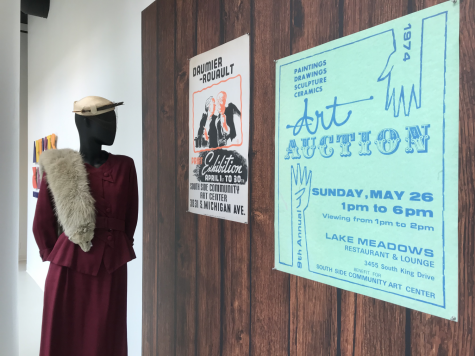Columbia students tell the story of the South Side Community Art Center’s impact with exhibit
May 2, 2021

Documents, event flyers and photos from the last 80 years tell the story of how a single community art center continues to foster emerging Black artists and how it embedded itself in the broader art world.
Records from the South Side Community Art Center, 3831 S. Michigan Ave., were curated as part of an exhibit titled “Artists and Models: A Tribute to the South Side Community Art Center,” at C33 Gallery, 33 W. Ida B. Wells Drive, and displayed from April 9 through April 29.
“Not only is it a wonderful exhibit, but it also paints a picture of a time frame for people who are coming and trying to get to know the center,” said Monique Brinkman-Hill, executive director of the South Side Community Art Center.
The C33 Gallery exhibit paid tribute to the South Side Community Art Center and covered four decades of history spanning from the center’s founding years during the Chicago Black Renaissance from the 1930s to the ’50s, through the Black Arts Movement in the 1960s and ’70s.
Founded by local artists and patrons in 1941, The South Side Community Art Center is one of 100 centers created as part of the Works Progress Administration’s Federal Art Project, which funded visual arts and artists across the U.S. during the Great Depression.
Today, it stands as the only remaining center that is a part of the project and continues to operate out of its original building in the Bronzeville neighborhood.
The C33 Gallery’s exhibit was curated by students in the Fall 2020 “Black Artistry and the Archive” course, taught by Melanie Chambliss, assistant professor in the Humanities, History and Social Sciences Department—and designed by students in the Spring 2021 “Graphic Design Practicum” course, taught by Sarah Faust, assistant professor of instruction in the Design Department.
Chambliss said her course focuses on the preservation of Black artistry, and the records were an opportunity brought to her by Duncan Mackenzie, chair of the Art and Art History Department and interim chair of the Design Department, and Philip von Zweck, academic manager of the Art and Art History Department.
With help from Head of College Archives and Special Collections Heidi Marshall, Chambliss said her students primarily focused on the records originally selected by the center throughout the semester. They also learned about Black artists through different mediums and how their work is impacted by the process of preservation.
The students wrote object essays on the records chosen, which included various letters, brochures and schedules, and created displays like the correspondence map—which visualizes the center’s connections across the country and in Chicago—and the community engagement wall, which allowed visitors to share their thoughts of the center and its impact.

Anastasia Murphy, a senior photography major and a curator for the exhibit, said it explored themes of resilience, relevance and resistance through telling the center’s story.
Murphy, who was in Chambliss’ “Black Artistry and the Archive” course, said a lot of the elements, like implementing wood panel designs behind the sidewalk displays and the red, purple and yellow colors used, were decided by the design students and inspired by the color palette in the center’s logo.
Written profiles for artists such as Margaret Burroughs, co-founder of the DuSable Museum of African American History, were created by students in the Spring 2021 “Written Thesis” course, taught by Amy Mooney, associate professor in the Art and Art History Department.
Other parts of the exhibit, such as mannequin displays, were curated by Jocelyn Brown, student intern in the “Fashion Study Collection” course, who said she was inspired by different eras included in the exhibit and initially had two pieces per decade before narrowing them down.
Brown, a senior fashion merchandising major, said she paired a 1930s burgundy suit with a cream-colored fox fur and a 1950s work dress on the Wabash Avenue display to show the class difference between the garments. The Ida B. Wells Drive display housed a green 1960s dress from French fashion designer André Courrèges.
“Fashion history in textbooks doesn’t really go into depth about how people of color fashion their bodies,” Brown said. “Whenever I get a chance to do that, it really gets me excited.”
With the exhibit ending, Faust said she and Chambliss are working on moving elements of the exhibit to the South Side Community Art Center and are finding ways to fit as much as they can in the space provided.
Brinkman-Hill said the center expects to host the exhibit from July to August, with the potential of leaving it open through September.
“I want to give credit to the students for doing an amazing job of pulling a timeline together that really represents the South Side Community Art Center,” Brinkman-Hill said. “This exhibit to me is a wonderful snapshot of part of our story.”







